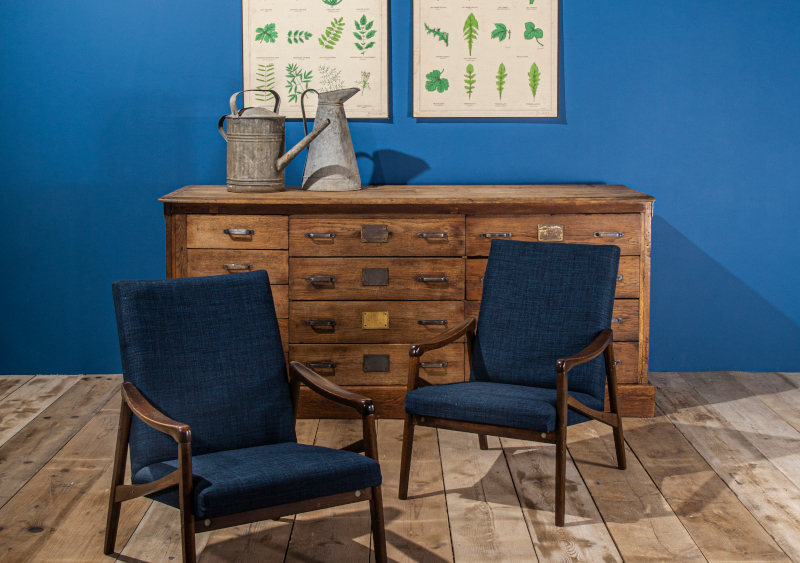I asked Paul Middlemiss, owner of Merchant & Found, to share his top tips for buying vintage well.
Paul Middlemiss has been buying furniture professionally for more than 30 years. His mother was one of Austalia’s best known antique dealers and as a teenager he would travel with her to Europe to trawl markets and buy and ship back vintage pieces. Here, Paul shares his tips on how to buy vintage furniture and furnishings.
Prior to setting up Merchant & Found in 2018, now one of the UK’s largest vintage furniture dealers, Paul held various posts including buying director at The Conran Shop and Habitat, owner of the General Trading company and managing director of Pedlars – the first mainstream vintage furniture retailer in the UK.

Paul says, “I am obsessed with furniture. Years of experience combined with obsession and passion means I spot the things that count. The ability to buy vintage furniture well comes from experience – I have made mistakes – paid too much for items and hugely underestimated restoration costs.
Since we started the business in 2018, we have grown to become one of the UKs largest vintage retailers, holding more than £400k of stock across two warehouses at any one time. We have earned a reputation for championing the forgotten maker – producers that were often huge in their day creating well designed and well-made pieces but for whatever reason, closed. Their furniture however, remains and many pieces are in my opinion set to become future classics – well priced now but not for long.”
Here are Paul’s top tips on how to buy vintage furniture:
- Follow your heart. If you love it then whether it’s a good or bad piece doesn’t really matter. At Merchant & Found we have the same fundamental philosophy but with a few others alongside – it must be well designed, well made, original i.e not been changed or messed around with, and lastly, is it a fair price?
- Is it original? We rarely buy anything restored as it loses its soul. We do restore and have a large workshop but we only aim to give everything a bit of love, make it presentable and practical but leave the scars – well made pieces generally wear them well.
- Design, proportion and quality. If a piece ticks all these boxes it is likely to be a stunner – does it sit with your other pieces – if so you’re onto a winner.
- Know when to walk away. Lights will always need rewiring. If you have the experience and know how then this is not a problem. Handles on cabinets are a nightmare – it’s impossible to match just one missing handle so often the only solution is to change them all and this can completely change the look of a piece. Is it unusual and worth saving? Try and work out the costs in your head and the possible pitfalls – if it doesn’t add up, walk away.
- Is it genuine? There are very good workshops out there that can do all sorts of things and it’s not limited to brown furniture. I have seen fake Robin Days and fake Ernest Race. It only really happens to expensive pieces because it’s economically viable so if you’re in the market for a design classic, buy from a reputable dealer.
- You can’t fake age. Look at the way it’s constructed – do the screws look old, are the joints handmade? The absolute tell-tale is Philips screws versus slotted screws – shiny versus old and rusty screws. Patina is hard to fake – take the glass on top of a haberdashery unit – if it’s been used in a shop for 75 years it’s going to be scratched and it’s those scratches that tell so many stories

- What to buy now. I think classic Scandinavian mid-century is plateauing as is French Brocante and shabby chic. Victorian furniture is rising and coming in from the cold – brown furniture is sort of coming back but there is a trend to repaint or strip – French polish is over. 60s and 70s furniture is having a big moment now so worth investing.
- Keep your eyes open. You can trawl vintage fairs and online sites but you can also make an unexpected discovery. Recently I heard about a café in Southend that was closing with a big collection of Bentwood chairs. I had stuff to do but when you get a tip off you have to just go. When I got there, it was a greasy spoon, very humble but inside was filled with very early 1910 Thonet chairs – it was thrilling.
- Use a Pallet. If you’re on holiday and don’t have a van or ability to transport you don’t have to leave it. Pallets are around 120cm so you can ship pretty much any size and if you have a very large piece you can just bolt two pallets together and put quite a large sideboard or table on top. It’s the Royal Mail of freight – safe and simple and costs under £200.
- What to buy. Tables – well-proportioned family tables. Baumann chairs are well made, elegant and for my money, classics of the future; interesting posters and graphics, educational charts have beautiful graphics and are timeless; Haberdashery units never go out of fashion; Banks of drawers – well-made and sturdy – often you cannot find better quality versions that are new. And lastly, big comfy mid-century armchairs – look great, feel great and will always hold their value.
(Stellar Works is re-issuing mid-century classics. Find out more here)




👋 These guys have awesome products. Keep sharing unique products and information with us.